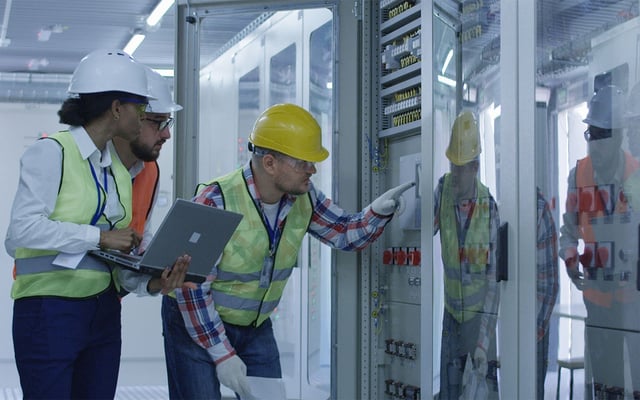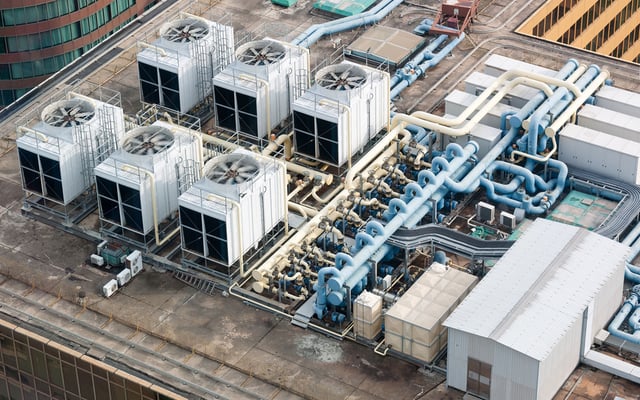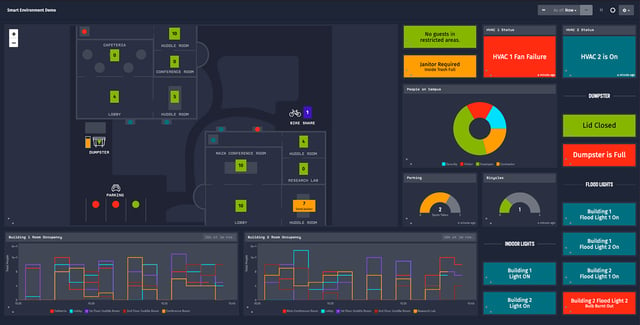In the simplest terms, building management systems are responsible for the regulation and control of facility systems. The advent of building management systems (BMS) was a massive leap forward in automating the equipment used to control facilities. BMS allows for a variety of hardware, primarily HVAC systems, to automate their responses to internal environmental conditions and timing. This was a boon for facilities, who now had access to more information necessary to perform their jobs. However, BMSes have always been developed with a focus on automation rather than optimization.
Building Management Systems And IoT
The emergence of the Internet of Things (IoT) in the last decade has opened up innovative ways for facility managers to leverage their existing building management systems alongside a wealth of IoT data. The combination of BMS and IoT can help building managers achieve optimization and ultimately create truly smart buildings.

Let’s take a look at the impact of building management systems and how you can combine this legacy technology with IoT to better manage your facilities.
Impact of BMS Technology
Building management systems are responsible for monitoring and maintaining control across systems that are common within a typical building, for example:
- HVAC Systems
- Hot Water Systems
- Technical Steam Systems
- Sprinkler Systems (for Fire Safety)
- Electric Monitoring Systems
Should any of these systems report values outside of their predetermined set points, such as temperature above a specified level, as reported by an HVAC system, alerts can be triggered and provided to the appropriate personnel. Moreover, systems can be configured to trigger at certain times of the day, like a cooling cycle beginning at 7:00 a.m. to cool the building before the start of the workday.

As this technology has evolved, it has allowed buildings to be better optimized for the personal comfort and security of its occupants, in addition to better control of energy expenditure. This leads to cost savings and lessens the impact on the environment. But where a BMS falls short is in how the data is provided to facilities managers and how using a BMS alone can lead to missed opportunities for building optimization and cost savings.
This is where IoT comes in.
Combining IoT and Building Management Systems
Building management systems provide data on the core operational systems within a facility and enable the automatic control of those systems. These systems ultimately allow a facility manager to optimize building performance. Bringing IoT into your buildings has largely the same goal, to provide data on the performance of your buildings’ systems and allow for optimization. Still, by its advanced nature, IoT can take this optimization much further than a typical BMS.
The vast array of IoT sensors that exist in the market, all for a fraction of the cost of a major facility system (i.e., HVAC), means that facilities managers can now install these sensors to monitor aspects of their facilities at a very granular level. The wide variety of sensors also allows you to collect data from sources outside of your building that directly impact the performance of facilities systems.
Imagine the savings a facilities manager can realize when integrating real-time weather data from outside the facility to better control the HVAC system. For example, knowing that a heatwave will spike temperatures later in the afternoon, the system can work to cool the building proactively to better maintain adequate internal temperatures. A traditional BMS cannot do this, but by pairing your BMS with IoT data, you can gain the benefits of both technologies.
A fascinating implementation of IoT and BMS is through the utilization of CO2 sensors in the workplace. CO2 levels can act as a proxy measurement for occupancy, as more people in a room lead to higher CO2 levels through exhalation. These CO2 levels can be used as a trigger for when a room is occupied and requires additional ventilation for temperature control, as maintained by your HVAC system.

Any facilities manager will be concerned with the cost of operating their facility and look for opportunities to reduce energy costs. Where a BMS provides you with data on your major operational units, IoT devices can be attached to all of your buildings’ equipment to monitor power consumption. This then ultimately provides a more accurate measurement of your utility consumption and can help managers identify inefficiencies. Many utility providers charge an inefficiency penalty for power consumption, and any data that can help close that gap is a consideration for managers.
Platforms to Integrate IoT and BMS
Without the right tools and method to bring IoT and BMS together, you aren’t reaching the maximum benefit. This is where an application enablement platform (AEP) like Losant can help.
AEPs can allow facilities managers to connect a wide variety of IoT devices to provide disparate data referenced above and can also allow for direct integration with industry-standard BMS communication protocols, such as BACnet. By providing a single destination for both IoT and BMS data, AEPs can solve the other major gap with legacy systems, which is the lack of analytics.
AEPs, such as Losant, provide data aggregation and visualization tools to allow for all types of data to be easily displayed and analyzed for facilities managers to better make decisions regarding the operation of their facilities. In the dashboard below, we are displaying BMS data such as HVAC status, directly alongside IoT data, like occupancy and parking availability, providing a more holistic view of your entire facility’s operation.

Legacy Systems in 2020
Although IoT has allowed certain industries to replace these legacy systems, the building management industry has the unique ability to leverage its existing systems alongside IoT to better optimize their facilities. BMS have gone through many iterations over the past decades, and will continue to be prevalent for major facilities equipment. When you consider the large capital expenditure required to acquire these systems, it makes sense that facilities managers will want to stay with a proven long-term technology.
However, finding a competitive advantage in the marketplace means enterprises need to look at all aspects of their organizations, and integrating an IoT strategy alongside their current facilities management plan, and an AEP may provide that advantage.
To help enterprises find that competitive edge, schedule a walkthrough of the Losant platform with one of our Solution Architects and learn how IoT can enable data-driven insights to enhance your facility.
